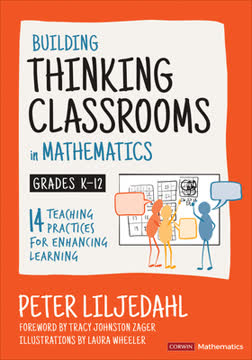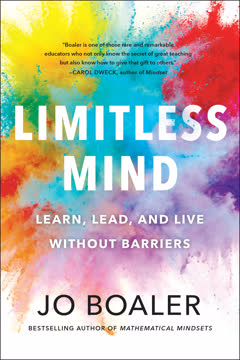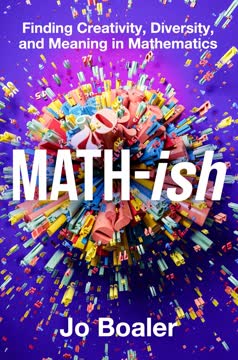Key Takeaways
1. The brain's plasticity enables growth and change at any age
When we learn a new idea, one of three things happens in the brain... The first possibility is that you start a new brain pathway. The more deeply you learn, the stronger the pathway becomes.
Brain plasticity revolutionizes learning. Neuroscience has shown that our brains are incredibly adaptable, capable of forming new connections and pathways throughout our lives. This challenges the traditional notion that mathematical ability is fixed or innate.
Key findings on brain plasticity:
- London taxi drivers' hippocampi grow with spatial learning
- Brain changes occur even with brief, 10-minute daily exercises
- Students with math learning disabilities show brain changes after tutoring
The implications for mathematics education are profound. It means that all students, regardless of age or background, have the potential to develop strong mathematical skills. Teachers and parents should encourage a growth mindset, emphasizing that mathematical ability can be developed through effort and practice.
2. Mistakes and struggle are essential for mathematical learning
Every time a student makes a mistake in math, a synapse fires.
Mistakes fuel brain growth. Research has shown that when we make mistakes, our brains experience increased electrical activity. This activity occurs even if we're unaware of the error, indicating that the process of struggling with a problem is itself valuable for learning.
Benefits of mistakes in mathematics:
- Increased brain activity and synapse firing
- Development of problem-solving skills
- Opportunity for deeper understanding
Educators should create environments where mistakes are welcomed and celebrated. This shift in perspective can help reduce math anxiety and encourage students to take intellectual risks. By framing struggle as a positive and necessary part of learning, we can help students develop resilience and a love for mathematical challenges.
3. Mathematics is a creative, visual, and connected subject
Mathematics is a cultural phenomenon; a set of ideas, connections, and relationships that we can use to make sense of the world.
Math is everywhere. Contrary to the common perception of mathematics as a rigid, procedural subject, it is fundamentally about patterns, creativity, and connections. Mathematics exists throughout nature, art, and the world around us.
Examples of mathematics in nature and culture:
- Fibonacci sequence in flower petals and pinecones
- Fractals in snowflakes and coastlines
- Mathematical models in computer-generated special effects
- Data analysis in criminal investigations
By presenting mathematics as a broad, multidimensional subject, educators can engage more students and help them see its relevance to their lives. Encouraging visual thinking, pattern recognition, and creative problem-solving can make mathematics more accessible and enjoyable for all learners.
4. Developing a growth mindset is crucial for mathematical success
Students with a growth mindset keep going even when work is hard and are persistent, displaying what Angela Duckworth has termed "grit".
Mindset shapes achievement. Research by Carol Dweck and others has shown that students' beliefs about their own abilities significantly impact their mathematical performance. Those with a growth mindset – the belief that intelligence and ability can be developed through effort – consistently outperform those with a fixed mindset.
Key aspects of a mathematical growth mindset:
- Belief that everyone can learn mathematics to high levels
- Valuing effort and perseverance over innate "talent"
- Seeing mistakes as opportunities for learning
- Embracing challenges as chances for growth
Educators and parents can foster growth mindsets by praising effort and strategies rather than intelligence, encouraging risk-taking, and framing struggles as normal and productive parts of the learning process.
5. Traditional teaching methods often hinder mathematical understanding
Mathematics has been pulled into a culture of performance and elitism in the United States, and I believe that to achieve higher and equitable outcomes we need to recognize the elitist role that mathematics often plays in our society.
Rethink math education. Many traditional approaches to teaching mathematics, such as heavy emphasis on memorization, timed tests, and rigid procedural methods, can actually impede deep understanding and enjoyment of the subject.
Problems with traditional math education:
- Overemphasis on speed and memorization
- Narrow focus on procedural fluency at the expense of conceptual understanding
- Use of tracking and ability grouping, which can reinforce fixed mindsets
- Reliance on pseudo-contexts that don't reflect real-world math applications
Instead, educators should focus on developing conceptual understanding, encouraging multiple solution strategies, and providing opportunities for creative problem-solving. This approach aligns more closely with how mathematicians actually work and helps students develop the flexible thinking skills needed in the modern world.
6. Equitable mathematics education requires dismantling harmful stereotypes
Mathematics is the subject most in need of a mindset makeover.
Math is for everyone. Persistent stereotypes about who can excel in mathematics – often based on gender, race, or socioeconomic background – create significant barriers to equitable education. These biases can lead to self-fulfilling prophecies, where students internalize negative beliefs about their mathematical abilities.
Strategies for promoting equity in mathematics:
- Challenging stereotypes about mathematical ability
- Providing role models from diverse backgrounds
- Using inclusive language and examples in teaching
- Offering high-level content to all students
- Implementing unbiased assessment practices
Educators must actively work to counteract these harmful stereotypes by providing encouragement and high expectations for all students, regardless of background. By creating inclusive classroom environments and using diverse examples and contexts, we can help all students see themselves as capable mathematicians.
7. Effective assessment focuses on learning, not performance
When students are given a percentage or grade, they can do little else besides compare it to others around them, with half or more deciding that they are not as good as others.
Rethink assessment practices. Traditional grading and testing methods often promote a fixed mindset and can be detrimental to student learning. Instead, assessment should be used as a tool for growth and improvement.
Principles of effective mathematical assessment:
- Providing specific, actionable feedback rather than just grades
- Using formative assessment to guide instruction
- Encouraging self-assessment and reflection
- Allowing multiple attempts and opportunities for improvement
- Focusing on understanding and problem-solving, not just correct answers
By shifting the focus from performance to learning, teachers can help students develop a growth mindset and take ownership of their mathematical development. This approach also provides more meaningful information to guide instruction and support student progress.
8. Rich mathematical tasks promote engagement and deeper understanding
When mathematics tasks are opened for different ways of seeing, different methods and pathways, and different representations, everything changes.
Design engaging math tasks. The quality of mathematical tasks has a significant impact on student learning and engagement. Rich, open-ended tasks that allow for multiple approaches and representations can deepen understanding and promote mathematical thinking.
Characteristics of effective mathematical tasks:
- Low floor, high ceiling (accessible to all, with room for extension)
- Multiple entry points and solution strategies
- Opportunities for visualization and representation
- Connections to real-world contexts or mathematical ideas
- Encouragement of reasoning and justification
By using tasks that embody these principles, teachers can create more engaging and intellectually stimulating math classrooms. These tasks allow students to experience mathematics as a creative, problem-solving discipline rather than a set of procedures to memorize.
9. Collaboration and communication are vital in mathematics learning
Mathematics is a very social subject, as proof comes about when mathematicians can convince other mathematicians of logical connections.
Math is a team sport. Contrary to the stereotype of the solitary mathematician, collaboration and communication are essential in mathematical practice. Group work and mathematical discussions can significantly enhance learning and understanding.
Benefits of collaborative mathematics:
- Exposure to diverse problem-solving strategies
- Development of communication and reasoning skills
- Increased engagement and motivation
- Opportunity to learn from peers' mistakes and insights
Educators should create opportunities for students to work together, explain their thinking, and critique each other's reasoning. This not only deepens mathematical understanding but also prepares students for the collaborative nature of many STEM careers.
10. Teachers play a critical role in fostering mathematical mindsets
Teachers are the most important resource for students. They are the ones who can create exciting mathematics environments, give students the positive messages they need, and take any math task and make it one that piques students' curiosity and interest.
Teacher mindset matters. The beliefs and attitudes of teachers have a profound impact on student learning and mindset development. Teachers who believe in their students' potential and create supportive, engaging learning environments can transform students' mathematical experiences.
Key teacher practices for fostering mathematical mindsets:
- Communicating high expectations for all students
- Emphasizing effort and process over innate ability
- Providing opportunities for productive struggle
- Modeling a growth mindset and enthusiasm for mathematics
- Using diverse and engaging teaching strategies
Professional development that helps teachers develop their own mathematical mindsets and effective teaching practices is crucial for improving mathematics education. By empowering teachers to create positive, growth-oriented math classrooms, we can help all students develop strong mathematical identities and skills.
Last updated:
FAQ
What's Mathematical Mindsets about?
- Focus on Mindset: The book emphasizes the importance of adopting a growth mindset in mathematics, which encourages students to believe in their ability to improve through effort and learning.
- Neuroscience Insights: It presents recent neuroscience research showing that the brain can grow and change through learning, debunking the myth of fixed mathematical ability.
- Equity in Education: Jo Boaler addresses inequities in math education, advocating for all students to have access to high-level mathematics and providing strategies for inclusive teaching.
Why should I read Mathematical Mindsets?
- Transformative Teaching Strategies: The book offers innovative methods to inspire students and foster a love for mathematics, with practical advice for classroom implementation.
- Empower Students: It helps teachers empower students to embrace challenges and view mistakes as growth opportunities, leading to improved engagement and achievement.
- Research-Based Evidence: Jo Boaler supports her claims with extensive research and case studies, making it a credible resource for educators seeking to enhance their teaching practices.
What are the key takeaways of Mathematical Mindsets?
- Embrace Mistakes: Mistakes are valuable learning opportunities, as they stimulate brain activity and promote neural connections.
- Flexible Number Sense: Developing a flexible approach to numbers encourages conceptual thinking and problem-solving skills.
- Equitable Access to Math: The book advocates for equitable strategies in math education, challenging stereotypes about who can succeed in mathematics.
How does Mathematical Mindsets define a growth mindset?
- Belief in Improvement: A growth mindset is the belief that intelligence and abilities can be developed through dedication and hard work.
- Impact on Learning: Students with a growth mindset are more likely to embrace challenges and view effort as a path to mastery.
- Encouraging Growth: Jo Boaler provides strategies for teachers to cultivate a growth mindset, such as praising effort rather than innate ability.
What role do mistakes play in learning mathematics according to Mathematical Mindsets?
- Catalysts for Growth: Mistakes stimulate brain activity and promote neural connections, enhancing cognitive engagement.
- Encouraging Resilience: Framing mistakes as growth opportunities encourages resilience and reduces math anxiety.
- Classroom Practices: Practical strategies include discussing errors openly and valuing the learning process over correctness.
How can teachers create a mathematical mindset in their classrooms?
- Use Rich Tasks: Engage students with open-ended tasks that allow for multiple methods and representations.
- Foster Collaboration: Group work and collaborative problem-solving promote mathematical understanding and diverse perspectives.
- Encourage Inquiry: Inquiry-based questions prompt critical and creative thinking, fostering ownership of learning.
How does Mathematical Mindsets address equity in math education?
- Equitable Access: Advocates for providing all students with access to high-level mathematics, regardless of background.
- Challenging Stereotypes: Emphasizes the need to challenge stereotypes about who can excel in mathematics.
- Strategies for Inclusion: Offers practical strategies like heterogeneous grouping and inquiry-based learning to ensure equitable engagement.
What are some effective mathematical tasks mentioned in Mathematical Mindsets?
- Growing Shapes Task: Encourages exploration of patterns and relationships visually, promoting deep understanding.
- Four 4’s Challenge: Fosters creativity and problem-solving by using four 4’s to create numbers from 1 to 20.
- How Close to 100?: A game that encourages strategic thinking and reinforces number sense in a fun way.
How can parents support their children’s mathematical mindset at home?
- Encourage Exploration: Use everyday situations to discuss math and encourage inquiry rather than rote memorization.
- Promote a Growth Mindset: Praise effort and persistence, helping children understand that challenges are part of learning.
- Engage in Math Together: Participate in math-related activities like games or puzzles to make math enjoyable and relatable.
What strategies does Mathematical Mindsets suggest for teaching heterogeneous groups?
- Open-Ended Tasks: Use tasks that allow students of varying abilities to engage at their own level, promoting exploration.
- Choice of Tasks: Empower students by providing choices that cater to their interests and strengths.
- Individualized Pathways: Create personalized learning experiences to allow students to progress at their own pace.
What is the significance of the Youcubed program mentioned in Mathematical Mindsets?
- Innovative Teaching Resources: Youcubed provides resources and strategies to promote a growth mindset and equitable practices.
- Focus on Engagement: Emphasizes engaging students through creative tasks that foster a love for math.
- Research-Based Approach: Grounded in research, it equips teachers with tools to support all students in their mathematical journeys.
What are the best quotes from Mathematical Mindsets and what do they mean?
- “Mathematics is a beautiful subject...”: Highlights math as more than numbers, focusing on understanding relationships and patterns.
- “Mistakes grow your brain!”: Encourages embracing challenges and viewing mistakes as essential for cognitive development.
- “Math is a growth subject...”: Reinforces that success in math is about persistence and effort, not innate ability.
Review Summary
Mathematical Mindsets promotes a growth mindset approach to teaching mathematics, challenging traditional methods. Boaler emphasizes the importance of mistakes, creative problem-solving, and removing fixed mindset barriers. The book advocates for eliminating tracking, reducing homework, and rethinking grading practices. Readers appreciate the practical strategies and research-based insights, though some find the writing repetitive. Many educators report feeling inspired to change their teaching methods after reading. While primarily focused on K-12, some readers found applications for higher education as well.
Similar Books








Download PDF
Download EPUB
.epub digital book format is ideal for reading ebooks on phones, tablets, and e-readers.







